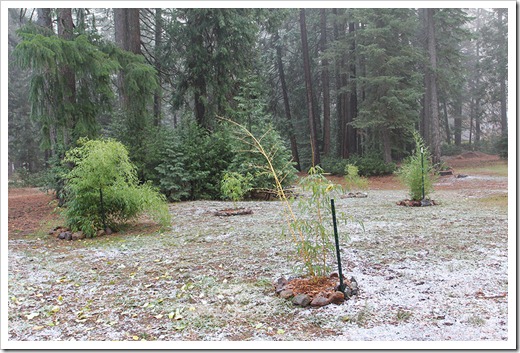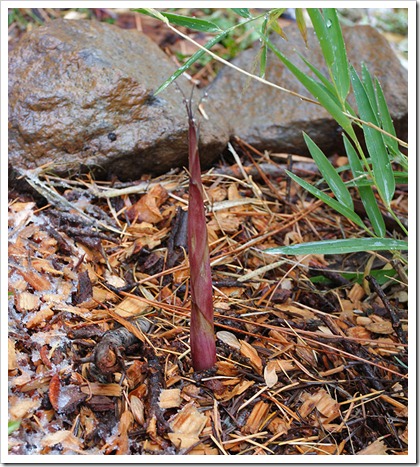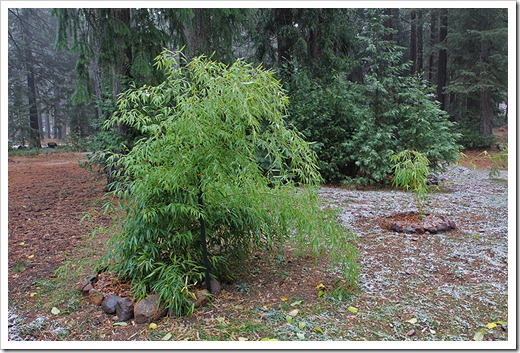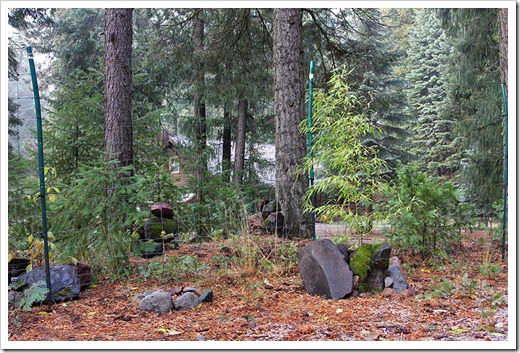Revisiting the bamboos-in-law
In the summer of 2010 we started to plant bamboos at my parents-in-law’s property in Mount Shasta in the mountains of far Northern California (USDA hardiness zone 7). It started with a golden vivax (Phyllostachys vivax ‘Aureocaulis’) and was soon followed by a black bamboo (Phyllostachys nigra ‘Punctata’). Now there are 12 different species of running and clumping bamboo growing in what we jokingly call “Experimental Bamboo Garden North.”
I’ve blogged about my “bamboos-in-law” before (1, 2, 3, 4, 5), and now it’s time for an early winter 2011 update. Most of the bamboos have been in the ground for a year or more now, and we’re beginning to see progress.
The first photo is a panorama of the backyard looking towards the house.
 |
| 1 Phyllostachys vivax ‘Aureocaulis’ |
Phyllostachys vivax ‘Aureocaulis’
This was the first bamboo we planted at my in-laws’ place. I got it as a 15-gallon specimen from a grower in Fair Oaks, CA. With its vibrant yellow culms, it has always been one of my favorites. Unfortunately, in the spring the leaves started to turn brown and the plant was looking like it was dying. After some initial puzzlement my mother-in-law identified the culprits as moles digging tunnels which were then used by voles eating the roots and possibly rhizomes. She collapsed the tunnels and installed a sonic mole repeller. Within six weeks, new leaves started to appear, sparse at first but eventually more numerous. In the summer, the plant produced a survival shoot, much smaller than the other culms but enough to keep the plant going. Hopefully within another year the plant will have made a full recovery.
 |
| Phyllostachys vivax ‘Aureocaulis’ |
  |
| Survival shoot on the right |
 |
| New branches and leaves on existing culms |
 |
| Sonic mole repeller |
Chusquea gigantea and Chusquea culeou ‘Roja’
Chusqueas are native to Central and South America. Many species are extremely cold-sensitive and only grow in tropical regions. Others are very cold-hardy but won’t tolerate hot summers, especially hot summer nights. These idiosyncrasies have severely limited their spread. They grow best in places like the Pacific Northwest (see my post about Tradewinds Bamboo Nursery in Gold Beach, OR). Judging from our initial experience with the Chusquea gigantea and Chusquea culeou in the next set of photos, Mount Shasta looks to be an agreeable environment as well.
  |
| Chusquea gigantea, planted in the fall of 2010 |
 |
| Late shoot on Chusquea gigantea. I’m not sure it will make it through the winter. After I took this photo, my father-in-law completely covered it with bark chips to give it some protection. |
The next one is Chusquea culeou ‘Roja,’ a special form of this clumping bamboo from the Andes that Tradewinds owner Gib Cooper found in batch of more than 1,000 seedlings. Similar to Chusquea culeou ‘Caña Prieta,’ new culms are dark red when exposed to the sun, slowly fading to greenish yellow. We planted this bamboo in July 2011 and it’s produced a couple of new culms since then. This will be its first winter in Mount Shasta, and it looks like it wasn’t fazed by the 19°F they recently had.
 |
| Chusquea culeou ‘Roja’ |
Phyllostachys nigra ‘Punctata’
This giant form of black bamboo started out in a half barrel but we put it in the ground in October 2010 (check out this post for details and photos). It’s grown much bushier this year but is still a fairly tight clump. I wonder if it will start to run next year?
 |
| Phyllostachys nigra ‘Punctata’ |
 |
| Phyllostachys nigra ‘Punctata’ |
Phyllostachys bambusoides
This is one of the most recent additions to my in-laws’ bamboo collection. I obtained it as a small 2-culm division from another collector and we planted it this past April. Looking at such a small plant, it’s easy to forget that Phyllostachys bambusoides has the potential to grow to 50+ ft.
 |
| Phyllostachys bambusoides |
 |
| Phyllostachys bambusoides |
The next photo shows a different view of the backyard bamboos, this time looking away from the house towards the southern end of the property. Bamboos # 3, 4 and 5 were already described above.
 |
| 1 and 2 Fargesia dracocephela ‘Rufa’ |
Fargesia dracocephela ‘Rufa’ and Fargesia denudata
The two ‘Rufas’ we planted in the fall of 2010 are doing well. The larger one, seen below in front of the chimenea, has quadrupled in size. The smaller one has doubled. Both started out as 1-gallon tissue cultured plants from Booshoot Gardens, purchased from Mad Man Bamboo.
 |
| Fargesia dracocephela ‘Rufa’ |
 |
| Fargesia dracocephela ‘Rufa’ |
The third fargesia, Fargesia denudata, was the same size as the two ‘Rufas’ above but hasn’t fared nearly as well. After last winter’s snow had melted, my in-laws thought it was dead, but it did produce leaves eventually. However, it has not increased in size. I have no idea why it’s not thriving. Fargesia denudata is certainly hardy enough for a zone 7 winter, so it can’t be that. Maybe its roots and/or rhizomes were nibbled on by voles? Hopefully we’ll see a big jump in size next spring.
 |
| Fargesia denudata |
There are three additional running bamboos on the western edge of the property. The largest one is a stone bamboo (Phyllostachys angusta) we planted in the summer of 2010 from a 15-gallon can. It’s as nice and bushy as it ever was and produced several tall culms this fall—much later than one would expect for a Phyllostachys (they typically shoot in the spring). With any luck, this stone bamboo will soon form a dense hedge to hide the mother-in-law cottage next door.
 |
| Phyllostachys angusta with Phyllostachys aureosulcata on the right (looking toward my in-laws’ house, away from the neighbors) |
The second bamboo in this area is a yellow-groove bamboo (Phyllostachys aureosulcata). This was a small 1-culm division when planted last summer. It’s still very small, but it did add another culm this year. Next year we should see a big increase in size and number of culms. Within 5 years it should live up to its potential (up to 40 ft. in height). The plan is to route its growth along the property line to provide visual protection from the neighbors.
 |
| Phyllostachys aureosulcata |
The final bamboo in the backyard is Phyllostachys bisettii. Like the fargesias described above, I bought it as a 1-gallon tissue culture plant. It has been in the ground a year now, and it has tripled in size. But it’s still small and difficult to spot, surrounded as it is by yellowing weeds. Things will look very different in this spot in just a few years!
 |
| Phyllostachys bisettii |
 |
| Phyllostachys bisettii surrounded by weeds |
Just on the other side of the chain-link fence, in what is technically the front yard, is the last of my in-laws’ bamboo, Phyllostachys nigra ‘Henon.’ Like many other bamboos, I got it as a small division. Planted just this past spring, it looks very happy in this spot on top of a rise. I have high hopes for this bamboo: With any luck, we should see the beginnings of a grove in 3-5 years. In zone 6, ‘Henon’ has the potential to grow to 60 (!) ft. in height.
 |
| Phyllostachys nigra ‘Henon’ |
 |
| Phyllostachys nigra ‘Henon’ |
The last photo in this post isn’t really related to bamboo, but it was taken from the spot where the ‘Henon’ is planted. It shows the house on the right and the tree-studded hill on the left. This is where we planted several dozen ornamental grasses and lavenders this past Easter (read about our planting party in this post).
 |


I think this spring will be an exciting one in their yard! My bissetii was a 1-gal Boo-Shoot plant too, and put out about 30 shoots its first spring, probably 100 its second, and I stopped counting this past spring. So that one may "explode" for them this spring. Actually, most of them should. Looking forward to reading about what happens.
ReplyDeleteAlan, I agree, spring 2012 could be very exciting. I'll be on hand to chronicle it all :-).
ReplyDeleteI didn't know your bisettii was a 1-gal Boo-Shoot plant. It's turned into a magnificent specimen!